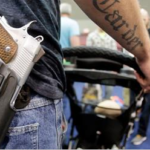From yesterday’s North Dakota Supreme Court decision in Keller v. Keller:
Karen Keller is married to Chad Keller. Chad Keller previously was married to Nichole Keller and they had three children together.
According to Nichole Keller, she emailed Chad Keller on August 14, 2016, stating she would like to pick up the two youngest children. Chad Keller responded that the children did not want to go with her. Nichole Keller sent another email later in the day saying she would come at 5:00 p.m. to see the children.
On August 14, 2016 Nichole Keller, accompanied by Rachel Parker, went to Chad Keller’s home to see her youngest daughter. Nichole Keller arrived at Chad Keller’s rural property around 5:00 p.m., but stayed at the end of the property line.
According to Nichole Keller, when she arrived Karen Keller came outside with her hands behind her back. Nichole Keller and Karen Keller were about 200 feet away from each other. Rachel Parker asked Karen Keller to get Nichole Keller’s daughter.
When Karen Keller turned to get the child they noticed Karen Keller was holding a handgun behind her back. Nichole Keller and Rachel Parker asked Karen Keller why she was carrying the handgun and Karen Keller responded she did not know the person Nichole Keller was with and did not trust her.
Nichole Keller testified that Karen Keller did not point the gun at her or make any threatening or violent statements. According to Nichole Keller, she is fearful for her life and the safety of her kids because of the August 14, 2016 incident. Nichole Keller and Rachel Parker left the residence and called the police. A deputy arrived and interviewed the parties.
This led to Nichole Keller getting a “disorderly conduct restraining order,” based on a finding that there was “reasonable grounds” to believe that Karen Keller’s actions were disorderly conduct. North Dakota law defines disorderly conduct as “intrusive or unwanted acts, words, or gestures that are intended to adversely affect the safety, security, or privacy of another person,” but expressly excluding “constitutionally protected activity.” The trial court concluded:
“[T]here was a gun. She brought it out on the property. And it’s obvious that Nichole was very scared. And she testified that she is still scared. And to me, that is the definition of gestures that are intended to adversely affect the safety, security, or privacy of another person. That’s the definition of disorderly conduct. Seems plain and simple to me….”
by Eugene Volokh



